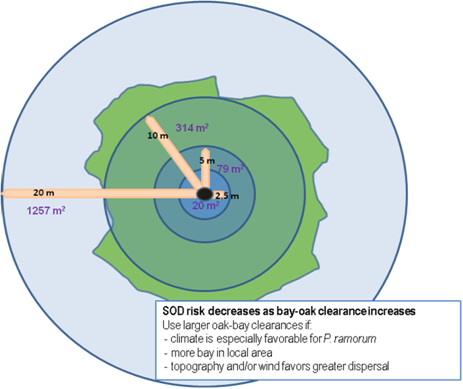
California bay removal reduces SOD risk by increasing the distance between the spore source (California bay leaves) and the target (a susceptible oak trunk). The number of P. ramorum spores that land on an oak depends on:
Increased California bay-oak clearance should be developed only by removal or pruning of California bay. Pruning off oak branches or stems to increase California bay-oak clearance is not recommended. No single prescription has been verified as effective for localized California bay removal. Consider the following general relationships and recommendations when implementing localized California bay removal:
When using localized California bay removal, it is often necessary to strike a balance between the maximum risk reduction (greatest clearance possible) and minimizing cost and environmental impacts (smallest clearance that will provide a substantial risk reduction). Each doubling of the desired clearance distance translates to a quadrupling of the area that needs to be cleared, with a corresponding increase in effort (fig. 3-2). In addition, California bay canopy within the area to be cleared may arise from a trunk located outside the clearance distance. Hence, California bays rooted outside of the target clearance distance may also need to be removed or pruned.

Figure 3-2—Bay removal area (blue circles) for four bay foliage-oak trunk clearance distances (orange arrows). Green outline represents a large oak canopy (about 22 m canopy diameter) with trunk shown as the central dot. The smallest clearance likely to provide a significant reduction in SOD risk is about 2.5 m. Although increasing clearances provide greater risk reduction, the area of bay removal quadruples with each doubling of the clearance distance.